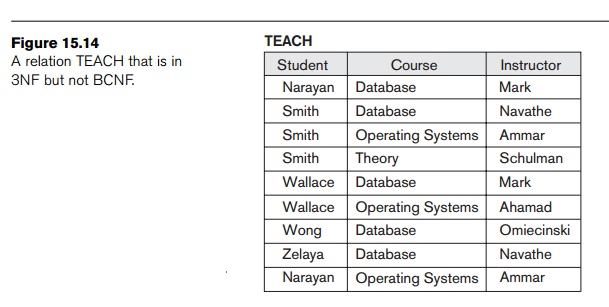Chapter: Fundamentals of Database Systems : Database Design Theory and Normalization : Basics of Functional Dependencies and Normalization for Relational Databases
Boyce-Codd Normal Form
Boyce-Codd Normal Form
Boyce-Codd normal form (BCNF) was
proposed as a simpler form of 3NF, but it
was found to be stricter than 3NF. That is, every relation in BCNF is also
in 3NF; however, a relation in 3NF is not
necessarily in BCNF. Intuitively, we can see the need for a stronger normal
form than 3NF by going back to the LOTS relation
schema in Figure 15.12(a) with its four functional dependencies FD1 through FD4. Suppose that we have thousands
of lots in the relation but the lots are from only two coun-ties: DeKalb and
Fulton. Suppose also that lot sizes in DeKalb County are only 0.5, 0.6, 0.7,
0.8, 0.9, and 1.0 acres, whereas lot sizes in Fulton County are restricted to
1.1, 1.2, ..., 1.9, and 2.0 acres. In such a situation we would have the additional
func-tional dependency FD5: Area → County_name. If we add this to the other
dependen-cies, the relation schema LOTS1A still is
in 3NF because County_name is a
prime attribute.
The area
of a lot that determines the county, as specified by FD5, can be represented by 16 tuples
in a separate relation R(Area, County_name), since there are only 16 pos-sible Area values (see Figure 15.13). This
representation reduces the redundancy of repeating the same information in the
thousands of LOTS1A tuples.
BCNF is a stronger normal form that
would disallow LOTS1A and
suggest the need for decom-posing it.
Definition. A relation schema R is in BCNF if whenever a nontrivial functional dependency X → A holds in R, then X is a superkey
of R.

The formal definition of BCNF differs from the definition of 3NF in that condition (b) of 3NF, which allows A to be prime, is absent from BCNF. That makes BCNF a stronger normal form compared to 3NF. In our example, FD5 violates BCNF in LOTS1A because AREA is not a superkey of LOTS1A. Note that FD5 satisfies 3NF in LOTS1A because County_name is a prime attribute (condition b), but this condition does not exist in the definition of BCNF. We can decompose LOTS1A into two BCNF relations LOTS1AX and LOTS1AY, shown in Figure 15.13(a). This decomposition loses the functional dependency FD2 because its attributes no longer coexist in the same relation after decomposition.
In
practice, most relation schemas that are in 3NF are also in BCNF. Only if X → A holds in a relation schema R with X not being a superkey and A
being a prime attribute will R be in
3NF but not in BCNF. The relation schema R
shown in Figure 15.13(b) illustrates the general case of such a relation.
Ideally, relational database design should strive to achieve BCNF or 3NF for
every relation schema. Achieving the normalization status of just 1NF or 2NF is
not considered adequate, since they were developed historically as stepping
stones to 3NF and BCNF.
As
another example, consider Figure 15.14, which shows a relation TEACH with the following dependencies:
FD1: {Student, Course} → Instructor
FD2:12 Instructor → Course
Note that
{Student, Course} is a candidate key for this relation and that the depen-dencies shown
follow the pattern in Figure 15.13(b), with Student as A, Course as B, and Instructor as C.
Hence this relation is in 3NF but not BCNF. Decomposition of this relation
schema into two schemas is not straightforward because it may be

decomposed
into one of the three following possible pairs:
{Student, Instructor} and {Student, Course}.
{Course, Instructor} and {Course, Student}.
{Instructor, Course} and {Instructor, Student}.
All three
decompositions lose the functional
dependency FD1. The desirable
decom-position of those just shown is 3 because it will not generate
spurious tuples after a join.
A test to
determine whether a decomposition is nonadditive (or lossless) is dis-cussed in
Section 16.2.4 under Property NJB. In general, a relation not in BCNF should be
decomposed so as to meet this property.
We make
sure that we meet this property, because nonadditive decomposition is a must
during normalization. We may have to possibly forgo the preservation of all
functional dependencies in the decomposed relations, as is the case in this
example. Algorithm 16.5 does that and could be used above to give decomposition
3 for TEACH, which yields two relations in
BCNF as:
(Instructor, Course) and (Instructor, Student)
Note that
if we designate (Student, Instructor) as a primary key of the
relation TEACH, the FD Instructor → Course causes a
partial (non-full-functional) depend-ency of Course on a part of this key. This FD may be removed as a part of second
normalization yielding exactly the same two relations in the result. This is an
example of a case where we may reach the same ultimate BCNF design via alternate
paths of normalization.
Related Topics